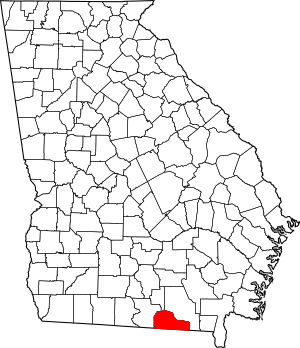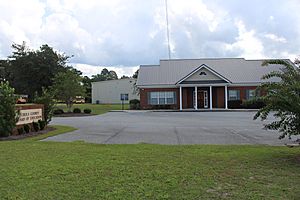Echols County, Georgia facts for kids
Quick facts for kids
Echols County
|
||
|---|---|---|

Echols County Courthouse in Statenville
|
||
|
||

Location within the U.S. state of Georgia
|
||
 Georgia's location within the U.S. |
||
| Country | ||
| State | ||
| Founded | December 13, 1858 | |
| Named for | Robert Milner Echols | |
| Seat | Statenville | |
| Largest community | Statenville | |
| Area | ||
| • Total | 421 sq mi (1,090 km2) | |
| • Land | 415 sq mi (1,070 km2) | |
| • Water | 5.8 sq mi (15 km2) 1.4%% | |
| Population
(2020)
|
||
| • Total | 3,697 | |
| • Density | 9/sq mi (3/km2) | |
| Time zone | UTC−5 (Eastern) | |
| • Summer (DST) | UTC−4 (EDT) | |
| Congressional district | 1st | |
Echols County (/ˈɛkəlz/) is a county located in the southeastern part of the U.S. state of Georgia. As of the 2020 census, the population was 3,697. The county seat is Statenville. Since 2008, Statenville is a disincorporated municipality. Echols and Webster counties are the only two counties in Georgia to currently have no incorporated municipalities. The county was established in 1858 and named in honor of Robert Milner Echols (1798–1847).
Echols County is part of the Valdosta, GA metropolitan statistical area.
Contents
History
On December 13, 1858, the Georgia General Assembly passed a bill establishing Echols County from a south-eastern section of Lowndes County and a south-western section Clinch County. The original borders of the county were a line from the mouth of the Suwanoochee Creek directly south to the state line, then along the state line, then north to the junction of Grand Bay Creek and Mud Swamp, then up the course of Grand Bay Creek to Carter's Ford, then a direct line to where Cow's Creek enters the Alapaha River, then up the creek to Griffins' Mill, then a direct line to Jack's Fort on Suwanoochee Creek, and then down Suwanoochee Creek to its mouth. With the exception of some minor adjustments of the border Echols shares with Lowndes and the loss of a thin strip to Florida following Florida v. Georgia, the borders of Echols County has changed little since its establishment. Statenville was declared the county seat in 1859.
At the time of the 1860 census, Echols County had a white population of 1,177, with 314 slaves, and no free people of color.
Echols County became notable as it has served as a place of banishment for many of Georgia's criminals. As the Georgia State Constitution forbids banishment beyond the borders of the state, officials instead ban the offender from 158 of Georgia's 159 counties, with Echols remaining as their only option. Few criminals have been documented as actually moving to Echols. This is because almost all banished criminals choose to leave the state instead of moving to Echols County.
Geography
According to the U.S. Census Bureau, the county has a total area of 421 square miles (1,090 km2), of which 415 square miles (1,070 km2) is land and 5.8 square miles (15 km2) (1.4%) is water. The county contains a notable swamp, Whitehead Bay.
The western half of Echols County is located in the Alapaha River sub-basin of the Suwannee River basin. The eastern half of the county, from well east of Statenville to just west of Fargo, is located in the Upper Suwannee River sub-basin of the same Suwannee River basin.
Major highways
Major waterways
- Alapaha River
- Alapahoochee River
- Grand Bay Creek (known in the 1800s as Irwin's River and later as Irwin's Creek)
- Suwannee River
- Suwanoochee Creek
Railways
- Georgia Southern and Florida Railway
- Seaboard Coast Line Railroad
- Plant System (now part of CSX)
- Statenville Railway (Defunct, it was used from 1910 to 1924. It ran from Statenville to Haylow, Georgia)
Adjacent counties
- Clinch County – northeast
- Columbia County, Florida – southeast
- Hamilton County, Florida – south
- Lowndes County – west
- Lanier County – north
Unincorporated communities
- Fruitland
- Howell
- Needmore
- Statenville (county seat)
Extinct town
- Tarver (formerly Statenville Station and Huckleberry)
Demographics
| Historical population | |||
|---|---|---|---|
| Census | Pop. | %± | |
| 1860 | 1,491 | — | |
| 1870 | 1,978 | 32.7% | |
| 1880 | 2,553 | 29.1% | |
| 1890 | 3,079 | 20.6% | |
| 1900 | 3,209 | 4.2% | |
| 1910 | 3,309 | 3.1% | |
| 1920 | 3,313 | 0.1% | |
| 1930 | 2,744 | −17.2% | |
| 1940 | 2,964 | 8.0% | |
| 1950 | 2,494 | −15.9% | |
| 1960 | 1,876 | −24.8% | |
| 1970 | 1,924 | 2.6% | |
| 1980 | 2,297 | 19.4% | |
| 1990 | 2,334 | 1.6% | |
| 2000 | 3,754 | 60.8% | |
| 2010 | 4,034 | 7.5% | |
| 2020 | 3,697 | −8.4% | |
| 2023 (est.) | 3,709 | −8.1% | |
| U.S. Decennial Census 1790-1880 1890-1910 1920-1930 1930-1940 1940-1950 1960-1980 1980-2000 2010 2020 |
|||
| Race / Ethnicity (NH = Non-Hispanic) | Pop 2000 | Pop 2010 | Pop 2020 | % 2000 | % 2010 | % 2020 |
|---|---|---|---|---|---|---|
| White alone (NH) | 2,688 | 2,555 | 2,328 | 71.60% | 63.34% | 62.97% |
| Black or African American alone (NH) | 252 | 163 | 147 | 6.71% | 4.04% | 3.98% |
| Native American or Alaska Native alone (NH) | 43 | 55 | 37 | 1.15% | 1.36% | 1.00% |
| Asian alone (NH) | 3 | 12 | 8 | 0.08% | 0.30% | 0.22% |
| Pacific Islander alone (NH) | 0 | 1 | 0 | 0.00% | 0.02% | 0.00% |
| Other race alone (NH) | 1 | 9 | 2 | 0.03% | 0.22% | 0.05% |
| Mixed race or Multiracial (NH) | 28 | 56 | 84 | 0.75% | 1.39% | 2.27% |
| Hispanic or Latino (any race) | 739 | 1,183 | 1,091 | 19.69% | 29.33% | 29.51% |
| Total | 3,754 | 4,034 | 3,697 | 100.00% | 100.00% | 100.00% |
As of the 2020 United States Census, there were 3,697 people, 1,561 households, and 1,097 families residing in the county.
Education
Echols County School District, the only school district in the county, operates public schools.
See also
 In Spanish: Condado de Echols para niños
In Spanish: Condado de Echols para niños



